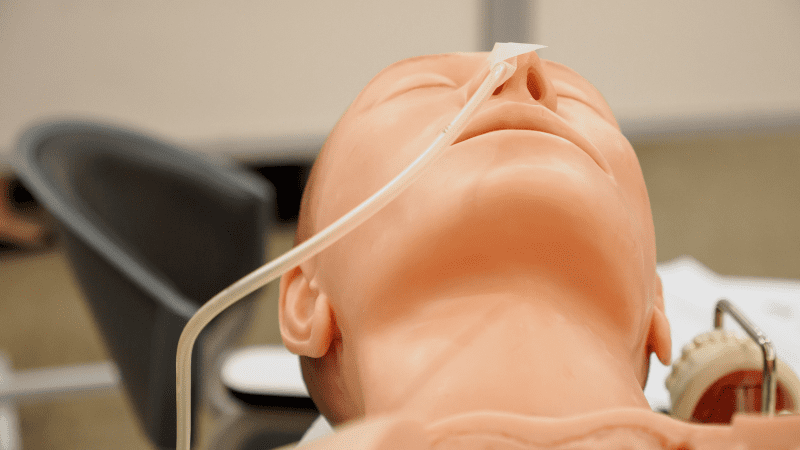What is Enteral Feeding?
Enteral feeding is a type of complex care. Here, we will provide more information such as who requires enteral feeding and different types.
People with complex healthcare needs can require a range of different care services as they return home from hospital. These include the likes of tracheostomy care, catheter care and often enteral feeding. But what exactly is enteral feeding, and how do our in-home carer’s take care of clients who require this type of complex care?
Here we detail what enteral feeding is, the different types and why it is so important.
What is enteral feeding?
Enteral feeding is a type of complex care activity provided to people who are unable to safely swallow or take in food by themselves. A plastic tube is inserted either through the nose or abdomen and into the stomach so that liquid food and medication can be easily administered.
There are several different types of enteral feeding, each one with different benefits and applications. The method of administering enteral feeding is dependent on the client’s condition and how long they require enteral feeding for.

Types of enteral feeding
- Nasogastric Tube (NGT)
This form of enteral feeding is more commonly used as a short-term measure while someone recovers to their former feeding state or as a bridge to the insertion of long-term tube placement e.g., PEG or RIG, which are more common in the community.
An NGT is a thin plastic tube that is fed through a person’s nose, down their throat and into their stomach. It is the least invasive type of enteral feeding but with higher risk, with a procedure that is quick, easy, and only mildly uncomfortable.
A person is still able to eat and drink with this type of tube, unless otherwise instructed, and is usually applied for people who require temporary enteral feeding for around 2- 4 weeks.
- Percutaneous Endoscopic Gastrostomy (PEG)
A plastic feeding tube is inserted through the abdomen and into the stomach so liquid can be fed directly into the stomach. This procedure is done surgically through what is
known as an endoscope, which takes around 20 minutes and is usually performed under anesthetic.
This method of enteral feeding is suited to people who need longer term feeding and can last for over a year before it needs to be replaced. It is a safe, comfortable, and convenient method of feeding, with the tube held in place by a disk that is fixed to the outside of a person’s abdomen.
- Radiologically Inserted Gastrostomy (RIG)
This form of enteral feeding is similar to PEG, with a tube that connects to the stomach through the abdomen. Carried out under local anesthetic, a tube with a small balloon on the end is guided into the stomach with the help of x-rays and local anesthetic.
Clients will need to change their PEG or RIG on a regular basis to ensure it works properly. This first change is done in the hospital but then after that, for those with balloon gastrostomies, they can have these changes performed in the home. Trained carers should also perform weekly balloon integrity maintenance checks. Additionally, there are weekly care tasks to be completed, which include advancing, rotating and resecuring the gastrostomy tube to prevent the part of the tube in the stomach becoming lodged.
Who requires enteral feeding?
This type of care is delivered to people who are unable to feed themselves. There are many different reasons someone may require enteral feeding, such as finding it difficult or being unsafe to swallow due to their health condition or injury.
It can be used temporarily to aid a person’s recovery or as a more permanent care service for those who are unable to take food or liquid due to an on-going condition. People who have suffered a stroke, spinal injury, brain injury, or a neurological condition like MND or MS may require enteral feeding as part of their care package. In fact, studies have shown that enteral feeding has become an increasingly vital element of at home care in recent years.
When caring for someone who requires enteral feeding, it is important that highly specialist care is given to prevent, identify and trouble shoot complications. This includes maintaining the gastrostomy stoma site, safely administering food and medication.
As with any complex care procedure it is important that the person is closely monitored by highly trained carers, like our nurse-led carers at HFH, for signs of infections. This helps to avoid unnecessary hospital admissions and to keep a person in good health as they are cared for in-home.
Complication of enteral feeding can include:
- Aspiration leading to pneumonia from enteral feed accidentally entering the lungs.
- Nausea, vomiting from a slow emptying stomach.
- Infection or skin irritation at tube insertion site.
- Dislodgement of the feeding tube or blockage.
- ‘Buried bumper’ where the internal fixator becomes enveloped by stomach wall.
Enteral feeding care at HFH
Our care teams are expertly trained in enteral feeding and other complex medical care procedures by our clinical team of Nurse Case Managers, with continuous on-going training and development to reinforce their skills. We take a highly personalised approach ensuring our in-home care is delivered to the highest of standards, with care plans individually tailored to each and every client, no matter how complex their needs.
If you would like to find out more about our complex care services then get in touch with our friendly team here or give us a call on 02086059714.









